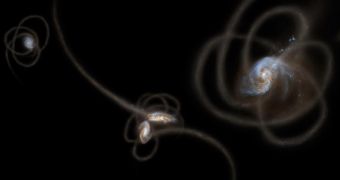Astronomers have cracked the mystery of the infrared background glow that has been observed but can't be accounted for. In essence, the universe is hotter than it should be, the amount of infrared light hitting us is more than could be generated by all the galaxies in the known universe.
What's more, the light isn't uniform, the "dark" sky isn't uniformly dark, small patches of infrared light are dotted throughout.
There have been several theories that attempted to explain this difference. One idea is that this light comes from very early and very far galaxies that we can't yet detect.
The second theory is that the light comes from galaxies that are closer, only four or five billion years away, but that are too dim to be seen in visible light.
It turns out, none of the theories is correct, but the second one came closer to the truth. Astronomers at UCLA and UC Irvine, found that there's a 1,000 times more light than distant, old galaxies would create.
In fact, there's 10 times more light than closer galaxies could create either. Using NASA's Spitzer Space Telescope, astronomers found that the excess light we see in the sky actually comes from stars that have been spun out of their galaxies.
Intergalactic stars, stars outside of regular galaxies, have been known to exist for 15 years.
It's the light from these stars that accounts for the excess we detect, the astronomers concluded. Their results have been published in Nature.
These stars are outside the bounds of the visible galaxy, made up of "luminous" matter, but inside the dark matter halo that is believed to surround all galaxies and which makes up some 95 percent of their mass, as is the case of the Milky way.
These stars are now believed to account for much of the background infrared light we can detect, but more research is needed.
Once again, the hope is that the James Webb Space Telescope will provide a much better picture, both literally and figuratively, as it will be able to better detect infrared light from far away galaxies and detect visible light from intra halo stars.

 14 DAY TRIAL //
14 DAY TRIAL //